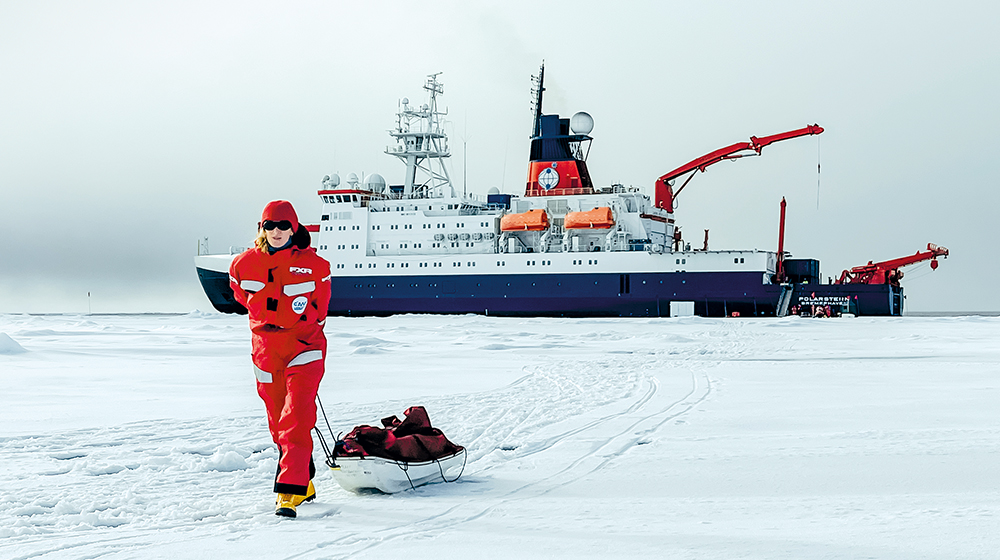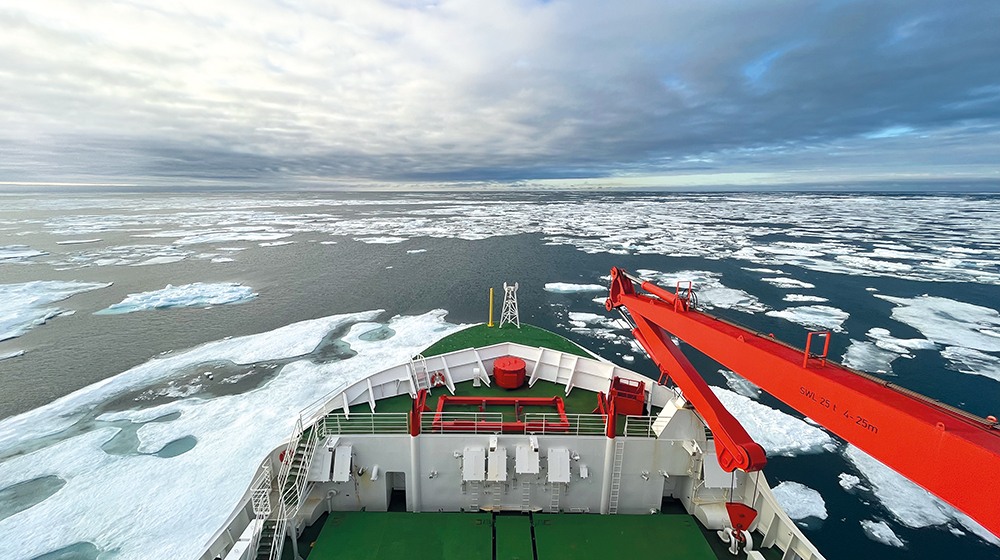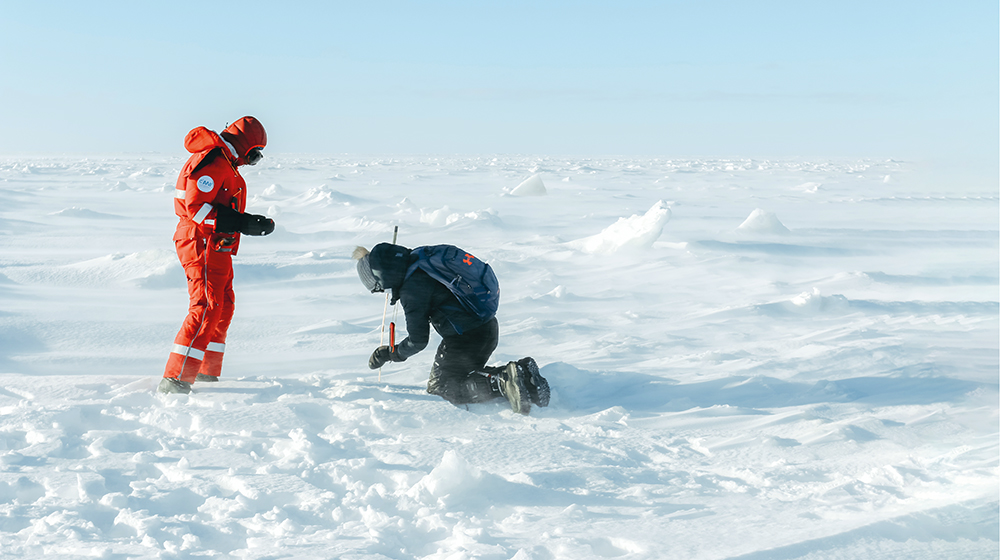
Wind howls around the bridge of the ship and a cracking sound reverberates through the icy air as, at a steady speed, the ship breaks through the meter-thick layer of ice beneath it. We feel the freezing temperatures on our faces as the cold bites at the only uncovered spot on the body that otherwise is wrapped in insulating outdoor clothing. No matter what direction we look in, all we see is the white and blue of countless icebergs against an endless sky, whilst in between numerous ice flows large and small swim on the rough sea.
These are the images that most of us would probably imagine we might see on a polar expedition. And although we might have seen them tens of times in documentaries or feature films, the majority of us will never have this experience in real life. However, for the mathematician, Dr. Carolin Mehlmann, from Otto von Guericke University Magdeburg, this is not the case. Together with her colleague, Professor Dr. Thomas Richter, she has just taken part in a two-month-long expedition to the Arctic Ocean. On August 2nd, 2023, in the Norwegian port of Tromsø, the two of them boarded the “Polarstern” research ship operated by the Alfred Wegener Institute, Helmholtz Center for Polar and Marine Research (AWI). They were part of a team of around 40 scientists from various disciplines that set out to gather data about the climatic changes in the central Arctic.
Within this framework, Dr. Carolin Mehlmann from the Institute for Analysis and Numerics at the University of Magdeburg was there to test a new numerical model that she had developed and that is intended to more reliably simulate and predict the precise movement and size of ice in the polar seas. Supported for three years by the German Research Foundation (DFG) to the tune of 300,000 euros, the new sea ice model should in future make it possible to analyze in greater detail the size and thickness of individual ice floes and their speed and direction of movement as well as to make an accurate prediction of their behavior. “I am interested in how quickly and where the ice moves and what happens when forces act on individual floes. My aim is to map this relationship in an equation,” explains the mathematician.
 Polarstern's journey through thin ice (Photo: Thomas Richter)
Polarstern's journey through thin ice (Photo: Thomas Richter)
She took part in the expedition to the Arctic so that she could test the validity of her calculation approach: “What was important was that my theoretical model showed exactly what I saw during my time on the research ship.” To this end, Dr. Mehlmann and her colleague, Professor Richter, took pictures of the ice floes, so that they could, among other things, precisely capture how they move. With a computer program they then extracted the characteristics of the floes, for example their shape or speed. “Over and above this, we documented the thickness of the floes, and also the forces acting on them, for example the wind.” The aim was to analyze the extent to which the existing model really was able to reflect the practical observations made during the expedition and, where necessary, to calibrate and adjust it.
What is fascinating about Dr. Mehlmann’s research is that she was able to observe the processes that she analyzes simultaneously. According to the scientist, it is rather unusual for a mathematician to be able to take part in an expedition to the Arctic Ocean. “As a mathematician, we tend to be thought of as theorists who move a few things around and sit at a desk. But that is not what it is like for me. With my scientific work I have the opportunity to change something, to make a difference and make a contribution to society in relation to the way we deal with climate change,” says Mehlmann. That has always been important to her. “That is also why I opted to study mathematics and although the people around me advised me to become a teacher, I made a conscious choice to become a researcher. Supposed barriers and obstacles that my peers point out to me tend to have the effect of making me want to achieve things more than ever. Apart from that, I want to research something that really has a clear relationship to the challenges facing society. Changes in the sea ice at both poles are one of the clearest indicators for the constant change in the climate on Earth.”
 Mathematicians Dr. Carolin Mehlmann and Prof. Dr. Thomas Richter taking a sample from an ice floe (Photo: Clara Burgard)
Mathematicians Dr. Carolin Mehlmann and Prof. Dr. Thomas Richter taking a sample from an ice floe (Photo: Clara Burgard)
And the joint expedition to the Arctic Ocean was not the mathematician’s first practical experience: “Back in 2017 I took part in an expedition to the Antarctic where I performed a support role. There too, the effects of climate change were clear to see. It is an important topic whose consequences affect us all. I hope, with my research, to be able to create a certain awareness for it too,” she says. Even if sea ice is a long way away from our everyday lives, changes occurring there will also affect us in Europe. The two-month expedition to the Arctic with her own research project this year was the culmination of a long-held dream for the scientist. “It is really something special to be able to see with my own eyes the sea ice that I model and simulate day in, day out on the computer in Magdeburg,” explains the mathematician.
Her new sea ice model could make a difference for the predictions of changes at the poles, since existing climate models only describe in mathematical terms how ice floes behave on average. To do this, statistical average values over a large number of floes are used. “Due to the warming currently taking place, the ice has become much less densely packed at the poles, which is why the assumption that it will be possible to find a sufficiently large number of ice floes no longer always applies. In the areas where there are no longer enough ice floes to be found, the equation that depicts the average floe movement, is no longer correct,” she explains. That is exactly where the scientist comes in: she is extending the existing model and in hers uses particles that move and interact with one another. “These particles represent small ice floes. I am therefore no longer modeling how everything generally behaves on average, but actually the individual floes.” Above all, her model is exciting because it is able to depict the so-called marginal ice zone, the border area between solid ice at the poles and the open ocean, in which many small interacting floes are located. “This zone is currently neglected in the existing climate models. There are simply no models available to map it. Due to climate change the marginal ice zone, however, is becoming ever larger and with my model it is now possible to represent it,” explains the mathematician. Mehlmann goes on to say that on the other hand, there are also phenomena at the poles that it has not been possible to explain thus far. “In the southern hemisphere, for example, there have been years where, despite warming, the ice increased even though the conventional models predicted a reduction. I hope that my model will soon be able to provide a better understanding of this behavior.”
At the beginning of October 2023, the “Polarstern” research ship finally returned to its home port of Bremerhaven after two months in the Arctic Ocean with Dr. Mehlmann and Professor Richter on board. In high summer, before the expedition began, the mathematician was excited to see the results that she would bring back with her to Magdeburg. “I am looking forward to the experience, to the opportunity to conduct research there and to share knowledge with international colleagues.” However, one thing is certain - the mathematician also hopes to make it possible for the general public to experience her research. For this reason, with colleagues from the Faculty of Mathematics at the University of Magdeburg she is planning a year themed around “Mathematics and Climate Change”, so that school students in particular can learn more about the expedition and gain a greater understanding of the subject.
In future, Dr. Carolin Mehlmann would like to devote her mathematical research to other aspects and make the world a little bit better. “I have so many ideas and can tell you that it won’t always be about sea ice. Perhaps some time I will travel to the moon,” she says with a wink.
Guericke Facts
- Dr. Mehlmann has been presented with the Karin Witte Women’s Sponsorship Award for her research.
- The Arctic remains one of the least explored areas on earth. It comprises the Arctic Ocean and the northern regions of the continents of Europe, North America and Asia.
- According to a study published by scientists from Norway and Finland in 2022, the temperature in the Arctic has risen at least four times as quickly as the global average since 1979.
